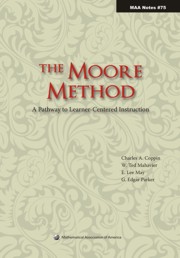Book contents
- Frontmatter
- Contents
- Dedication
- Acknowledgements
- 1 Introduction
- 2 Moore's Moore Method
- 3 What is the Moore Method?
- 4 On Culture
- 5 Development and Selection of Materials
- 6 In the Classroom
- 7 Grading
- 8 Why Use the Moore Method?
- 9 Evaluation and Assessment: Effectiveness of the Method
- 10 Frequently Asked Questions
- Appendices
- About the Authors
- References
- Index
10 - Frequently Asked Questions
- Frontmatter
- Contents
- Dedication
- Acknowledgements
- 1 Introduction
- 2 Moore's Moore Method
- 3 What is the Moore Method?
- 4 On Culture
- 5 Development and Selection of Materials
- 6 In the Classroom
- 7 Grading
- 8 Why Use the Moore Method?
- 9 Evaluation and Assessment: Effectiveness of the Method
- 10 Frequently Asked Questions
- Appendices
- About the Authors
- References
- Index
Summary
“The wise man doesn't give the right answers, he poses the right questions.”
—Claude Levi-StraussOver the years, each of us has fielded questions related to the Moore Method from audiences during presentations, from colleagues at conferences, and from friends and relatives. We've compiled here representative questions, along with responses, alphabetized by author.
Does the Moore Method work only for the bright students?
Do Moore Method instructors lecture?
Does the Moore Method cover less material?
Does the Moore Method work best in upper-level and graduate courses?
Does the Moore Method make the students do the work so the teacher doesn't?
Does the Moore Method work with cooperative learning?
Is there a list of features that define the method?
Does the Moore Method foster competition among students?
Are there better ways for students to present than writing on the board?
Does the Moore Method fail to equip those trained via the method, as students and later as professional mathematicians, with the ability to extract information from textbooks?
Are there professional risks associated with teaching a course by the Moore Method?
Are the goals for a Moore Method course the same as for a non-Moore Method course?
How does one prepare to teach a Moore Method course?
Are there lower or upper bounds on the size of a Moore-method class?
- Type
- Chapter
- Information
- The Moore MethodA Pathway to Learner-Centered Instruction, pp. 151 - 176Publisher: Mathematical Association of AmericaPrint publication year: 2009



